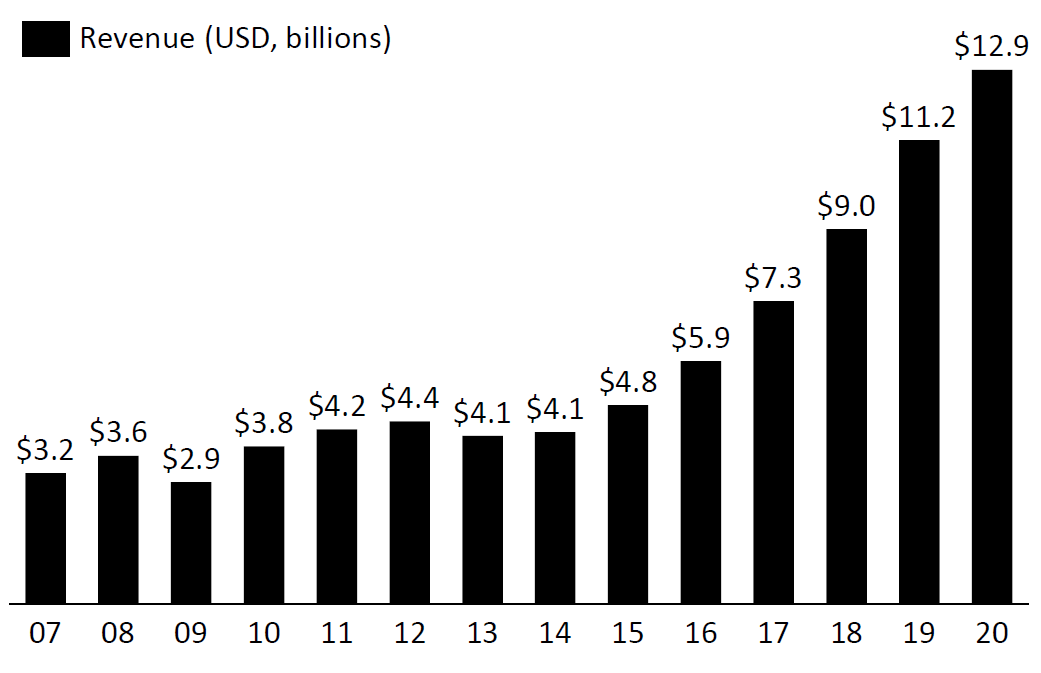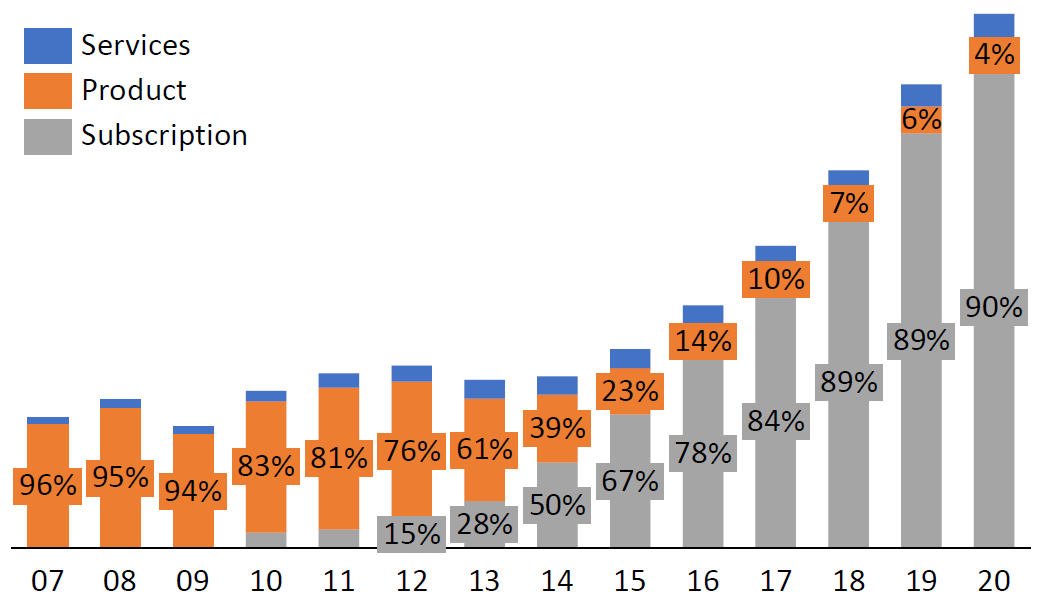A few weeks ago I came across a graph of Adobe’s annual revenue and was really surprised to see their recent strong growth. Their share price has performed better than Amazon over the last five years (~400% vs ~350%). Perhaps I’ve been slightly out of the loop, but I hadn’t heard much about them as a growing tech company so I wanted to understand what’s behind their growth.
Background
Adobe was founded in 1982 by John Warnock and Charles Geschke. It takes its name from the creek that ran behind John’s garage, where the founders initially set up shop. Its first product was PostScript, which was to become the industry-standard enterprise printer language within a few years. In the late 80s, it entered the consumer market with products such as Illustrator, Photoshop, and Acrobat Reader (they also created the PDF file format).
Fast forward to today, the business has more than 100 products that fall into two broad segments, as categorised by Adobe:
- Digital Media - tools that help create and publish content - customers include photographers, video editors, graphic designers, and marketers. Products include Photoshop, Illustrator, Premiere Pro, Acrobat Pro, and Sign.
- Digital Experience - tools that help businesses manage and measure customer experiences (e.g. customer analytics, customer targeting, and e-commerce management). Products include Experience Manager, Analytics, Customer Journey Analytics, Audience Manager, and Magento.
They technically have a third segment: Print and Publishing, but this a very small (~5%), legacy part of the business.
How has it been able to grow so strongly over the past 10 years?
1. Business model
The catalyst to much of Adobe’s growth is a shift towards a cloud-based subscription model. Before this, they had very expensive product license fees that allowed customers to use the software perpetually. At the beginning of the last decade, they started to switch customers to a subscription model, where customers pay a monthly fee to use products.
The subscription model has allowed Adobe to:
- Target new users - the new model lowers risk by reducing the upfront cost of the products and by giving flexibility in contracts. A perpetual Photoshop license cost around $700 in 2011, but the equivalent subscription was only $50 a month. __This opened up Adobe’s products to a host of smaller businesses and individuals–, in addition to other enterprise customers.
- Encourage wider use - Adobe has bundled their products into suites, where the pricing is set up in a way that it makes more sense to take all products in the suite vs a handful of individual ones. This encourages customers to use the other products and become further entrenched in the Adobe ecosystem.
- Deliver more value to the customer - customers benefit more from a cloud-based solution. It allows users to seamlessly hand files between products (e.g. from Premiere Pro to After Effects), and even access files through mobile and tablet apps. In the background, Adobe can continually improve its products, allowing customers to use the latest features without worrying about upgrade costs.
2. Product development and acquisitions
In the last ten years, Adobe has moved into adjacent spaces - e.g. from content creation software to marketing management and then to analytics. By moving into these adjacent spaces, they’ve been able to capture new customers whilst providing new value to existing ones. They’ve done this through product development and through acquisitions (23 acquisitions since 2009). Acquisitions also have the benefit of increased distribution through the acquired company’s customers.
3. Expanding markets
The markets in which they operate have been expanding and will continue to expand.
- Creative - the internet has allowed everyone to become a creator - e.g. YouTubers and photographers can make a living on the internet and need software for their work.
- Digital experience - Adobe launched their Experience Suite just as e-commerce and the smartphone were taking off, and in the last ten years, the number of people with internet access has more than doubled worldwide. This increase in internet users is good news for all businesses, but they need a way to track users, measure engagement, and better target potential customers. This is where Adobe’s products come in.
Closing thoughts
Adobe has a strong competitive position in the markets they operate and have a very diversified portfolio of products. Their core markets will continue to grow as the internet economy accelerates. However, they face competition from both traditional competitors (e.g. Apple) as well as non-traditional ones. The latter includes mobile-first photo or video editing apps and new SaaS analytics products, which don’t have the overheads of legacy tech companies.

